- About Ramapo
- Academics
- Admissions & Aid
- Student Life
- Athletics
- Alumni
- Arts & Community
- Quick Links
- Apply
- Visit
- Give
Auschwitz: 80 Years After (VR Exhibit)
We see in our students the future of Holocaust education
To commemorate the eightieth anniversary of the liberation of Auschwitz, the students in Dr. Jacob Ari Labendz’s Fall 2024 course on the Holocaust had the option to create (and submit as their final assignment) virtual exhibits about one aspect of life and death in Auschwitz.
The students built their exhibits on the popular gaming platform Fortnite, after receiving training from CleverLike Studios. Maddisyn Vaccaro, a student in the class and an intern for the Digital Humanities Program, provided technical assistance to her classmates.
The Impetus: Who will Tell Their Stories?
The slow and inevitable passing of the survivor generation poses a challenge to the field of Holocaust education. We have relied for decades upon survivors to share their stories, draw attention to the genocide, and inspire empathy and resolve within our communities.
CHGS trains students to embrace their roles as researcher/story-tellers. We see in them the future of Holocaust and genocide education. This demands more than teaching students to analyze historical sources and compose thoughtful papers, read by their professors alone.
Helping students create new knowledge of the past confers the responsibility to ensure that they can share their wisdom effectively. This means embracing the contemporary technologies upon which the younger generations rely—where they may be found and moved.
Auschwitz: An Overview
The Red Army liberated Auschwitz on January 27, 1945. By that point, the Nazis had evacuated most of the inmates—cruelly on so-called “death marches”—along with most of the guards and civilian staff. They had also destroyed much of the camp’s physical infrastructure to mask their crimes.
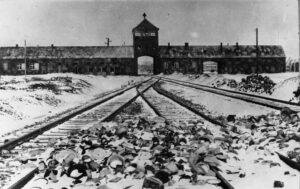
Main gate of Auschwitz after liberation
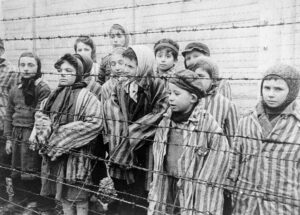
Children at liberation
The crimes. The Nazis transported more than 1.3 million individuals to Auschwitz between 1940 and 1945. This included nearly 1.1 million Jewish civilians (or, rather, civilians identified as Jews by the Nazis and their allies), of whom they murdered nearly 1 million. Other inmates included Polish political prisoners, Roma (arrested similarly on racial grounds), Soviet prisoners of war, and still others, including members of what we now identify as the LGBTQ+ community.
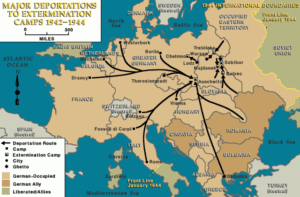
Map of major deportations to camps, 1942-1944 (USHMM)
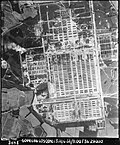
Auschwitz from a US spy plane, 1944
The crimes. Auschwitz comprised three camps, as well as numerous subcamps. Not only did the Nazis implement at Auschwitz a new method of gassing, utilizing the notorious pesticide Zyklon-B (hydrogen cyanide or prussic acid), but they also used the massive camp system as a source of enslaved labor and theft. The camp produced synthetic rubber for the German Army.
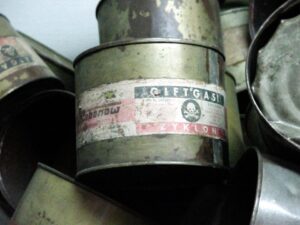
Zyklon-B canister
The crimes. Inmates whom the Nazis did not murdered upon arrival lived and died on starvation diets. Their overseers tormented them with tortures and humiliations. Doctors conducted brutal experiments on patients, many of them children and Roma, in the name of advancing racial and military sciences. Caged behind electrified barbed wire, the innocent lived moment-to-moment in a world of unpredictable horrors.
Resources for Further Education
Expert Overviews
Holocaust Testimonies
USH Shoah: Visual History Archive (over 1,000 videos available with free login)
Fortunoff Video Archive for Holocaust Testimonies (available on the Ramapo network)
Memoirs and Reflections
Charlotte Delbo, Auschwitz and After
Eli Wiesel, Night
Gisella Perl, I was a Doctor in Auschwitz
Halina Birenbaum, Hope is the Last to Die
Heda Margolius Kovály, Under a Cruel Star
Imre Kurtész, Fatelessness
Olga Lengyel, Five Chimneys
Primo Levi, The Drowned and the Saved
Primo Levi, Survival at Auschwitz
Rudolf Vrba, I Escaped from Auschwitz
Tadeusz Borowski, This Way to the Gas, Ladies and Gentlemen (fictionalized)
Viktor Frankl, Man’s Search for Meaning
Witold Pilecki, Witold’s Report from Auschwitz
Zalman Gradowski, From the Heart of Hell
Documentary Films
999: The Forgotten Girls (2024), directed by Heather Dune Macadam
Auschwitz: Inside the Nazi State and the “Final Solution” (2005) directed by Laurence Rees and Catherine Tatge
One Day in Auschwitz (2015), directed by Steve Percel and featuring survivor Kitty Hart-Moxon
Shoah (1985), directed by Claude Lanzmann
Recent Narrative Films of Excellence
Son of Saul (2015), directed by Lászlo Nemes
Zone of Interest (2023), directed by Beth Lane
Academic Books
Sarah M. Cushman, Joanne Pettitt, and Dominic Williams, eds., The Routledge Handbook to Auschwitz-Birkenau
Laurence Rees, Auschwitz: A New History
Nikolaus Wachsmann, KL: A History of the Nazi Concentration Camps
Robert Jan van Pelt, Auschwitz: Not Long Ago, Not Far Away (2017)
Robert Jan van Pelt, The Case for Auschwitz: Evidence from the Irving Trial (2002)
Sybille Steinbacher, Auschwitz: A History
Yisrael Gutman and Michael Berenbaum, editors, Anatomy of the Auschwitz Death Camp
Gratitude and Credit
CHGS thanks first its incredible students; those who contributed to this project and those who chose the alternate assignment. We thank Maddisyn Vaccaro, without whom this project would not have come to fruition.
CHGS would like to thank Dr. Sarah Koenig and the Digital Humanities Program for their partnership, which trained some fifty Ramapo students across multiple classes. Dr. Koenig allocated funds from her NEH Grant to support the program. Her students created an exhibition on six American freedoms. CHGS Pedagogy Programs Administrator Colleen Tambuscio co-led an additional CleverLike workshop for local educators, as well as Ramapo faculty and staff.
CHGS and DHP would also like to express our deepest gratitude to the Office of the Provost and the Ramapo College Foundation for a grant that made this all possible.
Copyright ©2025 Ramapo College Of New Jersey. Statements And Policies. Contact Webmaster.

Follow Us!